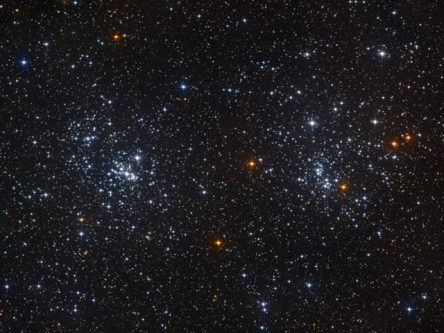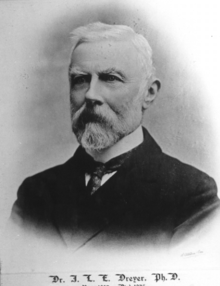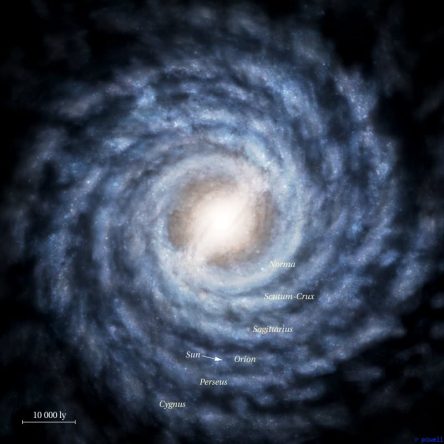 I’m just as human as anyone else, so if I see a good two-for-one deal, I’m going to take advantage of it. The universe occasionally makes these kinds of offers so that we stargazers can fit two (or more) celestial objects into a single field of view (i.e. double stars, galaxy pairs, galaxy clusters, lunar and planetary occultations, etc.). One of the very best astronomical two-fer specials is going on right now in our autumn sky with the Double Cluster in the constellation of Perseus. What we have with this offer are two splendid open star clusters that have been delighting backyard astronomers for ages.
I’m just as human as anyone else, so if I see a good two-for-one deal, I’m going to take advantage of it. The universe occasionally makes these kinds of offers so that we stargazers can fit two (or more) celestial objects into a single field of view (i.e. double stars, galaxy pairs, galaxy clusters, lunar and planetary occultations, etc.). One of the very best astronomical two-fer specials is going on right now in our autumn sky with the Double Cluster in the constellation of Perseus. What we have with this offer are two splendid open star clusters that have been delighting backyard astronomers for ages.
HOW TO FIND IT

The Double Cluster is easily found as it lies about half-way in between the distinctive W-shaped constellation of Cassiopeia and the bright star, Mirfak within the constellation of Perseus. You might also try locating the Double Cluster by first finding the stars Navi and Ruchbah in Cassiopeia. Draw an imaginary line in between the two. Now, extend that line out about 3 times the Navi-Ruchbah distance, you should then be right in the ballpark to find the Double Cluster.
 If your skies are dark enough, the Double Cluster can be seen as a faintly elongated smudge of light. Use binoculars to first locate and then explore them. Because these two distinct star clusters occupy 1 degree upon the sky (that’s the size of two full moons side by side or the width of your pinkie finger held all the way out to arm’s length), observing with binoculars or small telescopes at low power is ideal since they will give you the largest possible field of view.
If your skies are dark enough, the Double Cluster can be seen as a faintly elongated smudge of light. Use binoculars to first locate and then explore them. Because these two distinct star clusters occupy 1 degree upon the sky (that’s the size of two full moons side by side or the width of your pinkie finger held all the way out to arm’s length), observing with binoculars or small telescopes at low power is ideal since they will give you the largest possible field of view.
WHAT YOU ARE SEEING
 Star clusters are groups of stars that are gravitationally bound to one another. They come in two types: 1) globular star clusters are compact, symmetrical, spheroid-shaped masses of stars containing thousands of members and 2) open star clusters, which are composed of a few hundred members and are more loosely arranged than are the dense knots like those seen in globular clusters.
Star clusters are groups of stars that are gravitationally bound to one another. They come in two types: 1) globular star clusters are compact, symmetrical, spheroid-shaped masses of stars containing thousands of members and 2) open star clusters, which are composed of a few hundred members and are more loosely arranged than are the dense knots like those seen in globular clusters.
The Double Cluster is officially known as NGC 869 and NGC 884. These are catalog numbers in the New General Catalogue of celestial objects, fist established by John Dreyer in 1888.  While Dreyer may have been the first to give them an official catalog number, the clusters have been known since antiquity, having been mentioned as far back 130 BC by the Greek astronomer Hipparchos. You might also see the Double Cluster listed as Caldwell 14, from a catalog compiled by British astronomer Sir Patrick Moore and which was intended as a sort of supplement to the famed catalog by French astronomer Charles Messier. Moore and Messier’s catalogs are considered by many backyard stargazers as compilations of The Universe’s Greatest Hits, objects of unsurpassed beauty and are eagerly sought out by observers from around the world.
While Dreyer may have been the first to give them an official catalog number, the clusters have been known since antiquity, having been mentioned as far back 130 BC by the Greek astronomer Hipparchos. You might also see the Double Cluster listed as Caldwell 14, from a catalog compiled by British astronomer Sir Patrick Moore and which was intended as a sort of supplement to the famed catalog by French astronomer Charles Messier. Moore and Messier’s catalogs are considered by many backyard stargazers as compilations of The Universe’s Greatest Hits, objects of unsurpassed beauty and are eagerly sought out by observers from around the world.
NGC 869 and NGC 884 are both located in the constellation of Perseus and are said to represent the jeweled hilt of the sword that the Greek hero used in severing the head of Medusa from her body (the head of Medusa is represented by the variable star Algol).
As soon as you train your binoculars or small telescope onto the Double Cluster, you suddenly realize just why these two are so highly regarded by stargazers. Your field of view is instantly filled with a glittering array of hundreds of starry jewels set against a gorgeous background field of velvety black. The majority of these stars are hot blue-white supergiants but, look closely, and you will find some cooler yellow and orange stars scattered about the clusters. Subtle colors can be made more readily visible by slightly focusing and defocusing your telescope.
The clusters are estimated to be around 12.8 million years old, considerably younger than the familiar Pleiades star cluster, which has an estimated age of some 75 to 150 million years. By comparison, our own Sun is positively geriatric, with an age of some 5 billion years. The Double Cluster is also much further away from us than the Pleiades. The former are located 7,600 light years away (and are about 300 light years apart from one another) while the latter is a “mere” 444 light years distant. If the Double Cluster was as close to us as the Pleiades, you would see them filling up ¼ of the northern sky and many of their individual suns would be among our brightest stars. Given their ages and close proximity to one another, many astronomers believe that NGC 869 and NGC 884 were probably formed out of the same giant cloud of gas and dust.
Something fun to think about while observing the Double Cluster. As you know, the Milky Way is a spiral galaxy and our solar system is located within an arm of the Galaxy known as the Orion Arm. The Double Cluster is actually located in the arm adjacent to the Orion Arm and is known as the Perseus Arm.
and our solar system is located within an arm of the Galaxy known as the Orion Arm. The Double Cluster is actually located in the arm adjacent to the Orion Arm and is known as the Perseus Arm.
Autumn and winter are the best times of the year to view the Double Cluster, so be sure and find yourself a good dark sky, on a dark moonless night, and get outside to enjoy this stunning gathering of stellar gems.